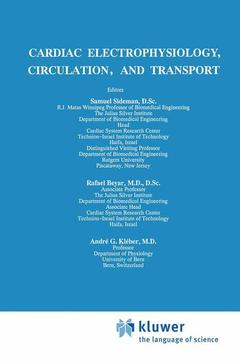Cardiac Electrophysiology, Circulation, and Transport, 1991 Developments in Cardiovascular Medicine Series, Vol. 121
Langue : Anglais
Coordonnateurs : Sideman S., Beyar Rafael, Kleber Andre G.

The cardiac system represents one of the most exciting challenges to human ingenuity. Critical to our survival, it consists of a tantalizing array of interacting phenomena, from ionic microscopic transport, membrane channels and receptors through cellular metabolism, energy production to fiber mechanics, microcirculation, electrical activation to the global, clinically observed, function, which is measured by pressure, volume, coronary flow, heart rate, shape changes and responds to imposed loads and pharmaceutical challenges. It is a complex interdisciplinary system requiring the joint efforts of the life sciences, the exact sciences, engineering and technology to understand and control the pathologies involved. The Henry Goldberg Workshops were set up to address these challenges. Briefly, our goals are: 1. To foster interdisciplinary interaction between scientists from different areas of cardiology, identify missing links, and catalyze new questions. 2. To relate micro scale cellular phenomena to the global, clinically manifested cardiac function. 3. To relate conceptual modeling and quantitative analysis to experimental and clinical data. 4. To encourage international cooperation so as to disperse medical and technological know how and lead to better understanding of the cardiac system. Today we celebrate the 7th birthday of a dream come true; a dream to bring together the diversified expertise in the various fields of science, engineering and medicine, to relate to the numerous interactive parameters and disciplines involved in the performance of the heart.
Modeling of Electrical Activity and Propagation.- 1 A Cellular Activation Model Based on Macroscopic Fields.- 2 Modeling of Cellular and Intercellular Propagation.- 3 Anisotropic Conduction and Inhomogeneity in Refractoriness.- 4 Different Mechanisms for Reentry in the Epicardial Border Zone of Healing Canine Infarcts: The Roles of Functional and Anatomical Conduction Block.- 5 Effects of Intercellular Resistive Coupling on Action Potential Initiation.- 6 Reentry of Cardiac Excitation: A Simulation Study.- 7 Conduction Velocity Variability in the Ischemic Myocardium as the Cause of Reentrant Arrhythmias.- Propagation of the Cardiac Impulse.- 8 Determinants of Action Potential Transfer From Cell to Cell.- 9 The Effect of the Finite Extracellular Resistance on Impulse Conduction in the Ventricular Myocardium.- 10 The Effects of Potassium on Anisotropic Conduction.- 11 Effect of Ryanodine and Other Modulators of Intracellular Calcium on Impulse Propagation During Simulated Ischemia.- 12 Low Dimensional Chaos and the Transition From Rhythmic to Arrhythmic Behavior in Cardiac Tissue.- 13 Fractal Mechanisms in Cardiac Electrophysiology.- Cell Physiology and Pathophysiology.- 14 Cardiac Sodium Channel Kinetics.- 15 Regulation of Cationic Flux Through Cardiac Sarcoplasmic Reticulum.- 16 Voltage Clamp Tests of a Model of Calcium Handling by Myocardial Cells.- 17 Modulation of Ventricular Impulse Initiation and Repolarization by Sympathetic Innervation.- 18 Relating Membrane Receptors to Drugs.- 19 Excitation—Contraction Coupling in Stunned Myocardium.- 20 Biochemical Mechanisms Contributing to Arrhythmogenesis During Ischemia.- 21 The Control of Cardiac Adenine Nucleotides: The Discovery and Potential Function of High—Energy Oligomeric Derivatives of ATP.- 22 On the Contractile Mechanism in Cardiac Muscle.- Myocardial Mechanics.- 23 Modeling the Effect of Contractility on Distribution of Coronary Flow.- 24 Intramyocardial Pressure Revisited.- 25 On the Mechanism of Transmural Myocardial Compression and Perfusion.- Circulation and Coronary Flow.- 26 A Model for Disturbed Coronary Artery Flow with Phonocardiography Verification.- 27 Left Ventricular Pressure Versus Contractility as Causes for Pulsatile Coronary Flow.- 28 Are Flow Transport Capacities and Metabolic Requirements Matched Regionally in the Myocardium?.- 29 Diminished Tolerance to Ischemia of Hypertrophied Hearts.- 30 Capillary Growth in Normal and Hypertrophic Heart.- Myocardial Metabolism and Energetics.- 31 Myocardial Blood Flow and Oxidative Metabolism Findings in Normal and Diseased Myocardium.- 32 Oxidative Substrate Metabolism in Reperfused Myocardium.- 33 The Role of Driving Forces in Myocardial Energy Metabolism and Transport Processes.- 34 The Effect of Exogenous Lactate and Pyruvate on Triacylglycerol Turnover in the Normoxic Heart.- General Discussion.- 35 General Discussion: Propagation and Arrhythmias.- Muscle Function and Coronary Flow.- CA2++ and the Membrane.- Metabolism and Transport.- Closing Remarks Samuel Sideman Rafael Beyar: Moderators.
Date de parution : 11-2012
Ouvrage de 387 p.
15.5x23.5 cm
Disponible chez l'éditeur (délai d'approvisionnement : 15 jours).
Prix indicatif 210,99 €
Ajouter au panierThème de Cardiac Electrophysiology, Circulation, and Transport :
Mots-clés :
cardiac function; circulation; electrophysiology; heart; heart rate
© 2024 LAVOISIER S.A.S.



